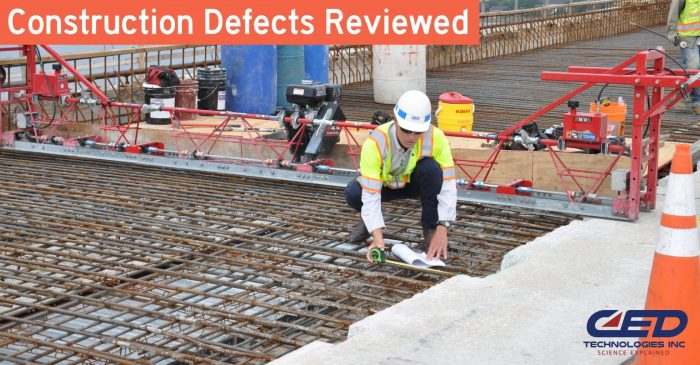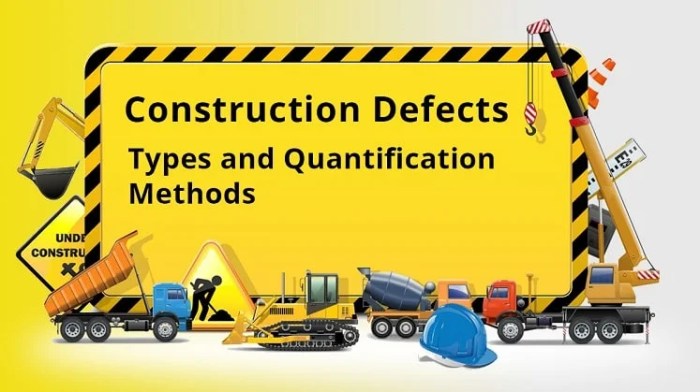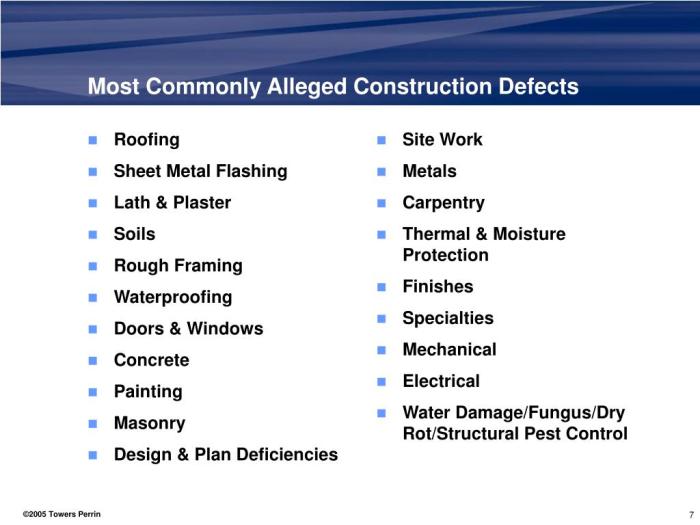Common construction defects and solutions are crucial aspects of building projects. From structural issues to waterproofing problems, this topic delves into key challenges and effective remedies within the construction industry. Let’s explore how identifying and addressing these defects can ensure the longevity and safety of structures.
Common Construction Defects
Construction defects are issues that arise during the building process and can compromise the structural integrity of a building. Identifying and addressing these defects is crucial to ensure the safety and longevity of the structure.
1. Cracks in the Foundation
Cracks in the foundation can weaken the entire structure of a building, leading to water infiltration, mold growth, and potential collapse. These cracks can be caused by poor soil compaction, improper drainage, or subpar concrete mixtures.
2. Water Damage
Water damage is a common defect that can result from leaks in the roof, windows, or plumbing systems. It can cause rot, mold growth, and compromise the structural integrity of the building. Proper waterproofing and drainage systems are essential to prevent water damage.
When it comes to programming, one of the first things you learn is the famous phrase ” Hello world! “. It serves as a simple yet essential introduction to the world of coding. This phrase is often used as the initial output in a new program, symbolizing the beginning of a journey into the realm of technology and innovation.
3. Improper Insulation
Improper insulation can lead to energy inefficiency, moisture buildup, and uncomfortable living conditions. Inadequate insulation in walls, ceilings, and floors can result in increased heating and cooling costs and reduced indoor air quality.
4. Poor Ventilation
Poor ventilation can cause moisture buildup, mold growth, and poor indoor air quality. Proper ventilation systems in bathrooms, kitchens, and basements are essential to prevent health hazards and structural damage.
When it comes to programming, one of the first things you learn is the famous phrase ” Hello world! “. It serves as a simple yet crucial introduction to the world of coding. This phrase is often the starting point for beginners to test their skills and see their first program in action.
So, embrace the journey of coding with a warm “Hello world!” message.
5. Structural Settlement
Structural settlement occurs when the foundation of a building sinks or shifts, leading to uneven floors, cracked walls, and misaligned doors and windows. It can be caused by poor soil conditions, inadequate foundation design, or improper construction techniques.
Structural defects: Common Construction Defects And Solutions

Structural defects in construction refer to issues that affect the stability, strength, and integrity of a building’s framework. These defects can compromise the safety of occupants and lead to costly repairs if not addressed promptly.
Common Structural Defects
Some of the most common structural defects encountered in construction include:
- Foundation problems such as settling or cracking
- Roof truss issues like sagging or improper installation
- Wall cracks due to poor construction or soil movement
- Structural framing errors leading to instability
Causes of Structural Defects
These structural defects can be caused by various factors, such as:
- Poor workmanship during construction
- Inadequate design or planning
- Environmental influences like soil movement or seismic activity
- Use of substandard materials
Risks Associated with Structural Defects
Structural defects pose significant risks to buildings and occupants, including:
- Structural failure leading to collapse
- Safety hazards for occupants and neighboring properties
- Decreased property value and difficulty in selling
- Litigation and costly repairs
Solutions and Preventive Measures
To avoid structural defects in construction, it is crucial to implement the following solutions and preventive measures:
- Engage qualified and experienced professionals for design and construction
- Regular inspections and maintenance to identify issues early
- Use of high-quality materials and proper construction techniques
- Compliance with building codes and regulations
Waterproofing issues
Waterproofing is a crucial component in construction to prevent water intrusion, which can lead to severe structural damage over time. Common waterproofing issues seen in buildings include inadequate sealing around windows and doors, poorly installed or degraded roof membranes, and improper drainage systems.
Effective Waterproofing Solutions, Common construction defects and solutions
Effective waterproofing solutions involve using high-quality materials and implementing proper techniques during construction. Examples of waterproofing materials include waterproof membranes, sealants, and coatings. Waterproofing methods such as installing proper flashing, using waterproofing admixtures in concrete, and ensuring proper slope for drainage are essential to prevent water damage in buildings.
Electrical and Plumbing Defects

Electrical and plumbing defects are common issues in construction that can lead to safety hazards if not addressed properly. It is essential to identify these defects early on and implement best practices to ensure the safety and functionality of the building.
Common Electrical Defects
Some common electrical defects in construction include:
- Exposed wiring
- Overloaded circuits
- Poor grounding
- Incorrectly installed outlets and switches
Safety Hazards Associated with Electrical Defects
Electrical defects can pose serious safety hazards, including the risk of electrical fires, electric shock, and damage to appliances and electronics. It is crucial to address these defects promptly to avoid any potential accidents.
Best Practices for Electrical Installations
When it comes to electrical installations, it is important to follow these best practices:
- Hire a licensed electrician for all electrical work
- Ensure proper insulation and protection for wiring
- Regularly inspect and maintain electrical systems
- Adhere to building codes and regulations
Common Plumbing Defects
Some common plumbing defects in construction include:
- Leaking pipes
- Poor drainage system design
- Improperly installed fixtures
- Inadequate water pressure
Safety Hazards Associated with Plumbing Defects
Plumbing defects can lead to water damage, mold growth, and health hazards due to contaminated water. It is essential to address these defects to maintain a safe and healthy living environment.
Best Practices for Plumbing Installations
To ensure proper plumbing installations, consider the following best practices:
- Hire a licensed plumber for all plumbing work
- Regularly inspect for leaks and water damage
- Properly insulate pipes to prevent freezing in cold climates
- Use high-quality materials for plumbing fixtures and fittings
Closing Summary

In conclusion, understanding common construction defects and solutions is vital for maintaining the quality and durability of buildings. By implementing preventive measures and proper maintenance routines, construction professionals can mitigate risks and ensure the structural integrity of their projects.